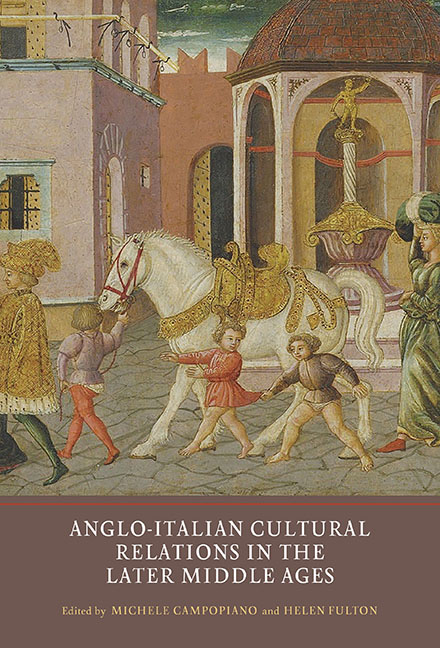Book contents
- Frontmatter
- Contents
- List of Illustrations
- List of Contributors
- Acknowledgements
- List of Abbreviations
- Introduction: Historical and Literary Connections between Britain and Italy in the Middle Ages
- 1 Writing, Translating and Imagining Italy in the Polychronicon
- 2 Richard de Bury, Petrarch and Avignon
- 3 The Reception of Italian Political Theory in Northern England: Bartolus of Saxoferrato and Giles of Rome in York
- 4 Italian Firms in Late Medieval England and their Bankruptcy: Re-reading an Old History of Financial Crisis
- 5 ‘Nostri Fratelli da Londra’: The Lucchese Community in Late Medieval England
- 6 ‘Saluti da Londra’: Italian Merchants in the City of London in the Late Fourteenth and Early Fifteenth Centuries
- 7 Political Joachism and the English Franciscans: The Rumour of Richard II's Return
- 8 Urban History in Medieval and Early Modern Britain: The Influence of Classical and Italian Models
- Afterword: The Nature of Anglo-Italian Cultural Exchanges
- Bibliography
- Index
2 - Richard de Bury, Petrarch and Avignon
Published online by Cambridge University Press: 03 July 2019
- Frontmatter
- Contents
- List of Illustrations
- List of Contributors
- Acknowledgements
- List of Abbreviations
- Introduction: Historical and Literary Connections between Britain and Italy in the Middle Ages
- 1 Writing, Translating and Imagining Italy in the Polychronicon
- 2 Richard de Bury, Petrarch and Avignon
- 3 The Reception of Italian Political Theory in Northern England: Bartolus of Saxoferrato and Giles of Rome in York
- 4 Italian Firms in Late Medieval England and their Bankruptcy: Re-reading an Old History of Financial Crisis
- 5 ‘Nostri Fratelli da Londra’: The Lucchese Community in Late Medieval England
- 6 ‘Saluti da Londra’: Italian Merchants in the City of London in the Late Fourteenth and Early Fifteenth Centuries
- 7 Political Joachism and the English Franciscans: The Rumour of Richard II's Return
- 8 Urban History in Medieval and Early Modern Britain: The Influence of Classical and Italian Models
- Afterword: The Nature of Anglo-Italian Cultural Exchanges
- Bibliography
- Index
Summary
Francesco Petrarca (1304–74) termed Avignon ‘Babylon on the Rhône’, a place he described as a site of greedy struggle, moral turpitude and tartarean darkness, a den of thieves where ‘there is no guardian for virtue, justice has perished, liberty has died, equity has vanished, pleasure rules, avarice rages, and envy seethes’. But while for Petrarch Avignon represented the corrupting confluence of secular and ecclesiastical power, he joined the household of Cardinal Giovanni Colonna there in 1326, and Avignon was where he first saw Laura, in April of 1327. Indeed, it is hard to overestimate the degree to which Avignon in the early fourteenth century flourished as a kind of cultural entrepôt, a place of exchange and profit where Italian, French and English ecclesiasts and diplomats met. Beryl Smalley has made this case succinctly: ‘Clerical Europe in the late thirteenth and early fourteenth centuries was still a family with its centre at the Curia.’ The papal court was the destination for those who sought preferment, confirmation, connection and material benefits. The English scholar, cleric and bibliophile Richard de Bury (1287–1345) journeyed there twice on the king's business, in 1330 and 1333. In addition to being appointed a papal chaplain, it was there that he secured the wealthy bishopric of Durham and there that he met his fellow bibliophile Petrarch in 1333 while on a diplomatic mission for Edward III. Petrarch recalled that meeting and his impression of the English cleric in a letter written to Tommaso da Messina on the subject of Petrarch's hope that de Bury might be able to tell him the location of the legendary northern land of Ultima Thule:
Michi quidem de hac re cum Ricardo, quondam Anglorum regis cancellario, sermo non otiosus fuit; viro ardentis ingenii nec literarum inscio, et qui, ut in Britannia genitus atque educatus abditarumque rerum ab adolescentia supra fidem curiosus, talibus presertim questiunculis enodandis aptissimus videretur.
- Type
- Chapter
- Information
- Publisher: Boydell & BrewerPrint publication year: 2018

